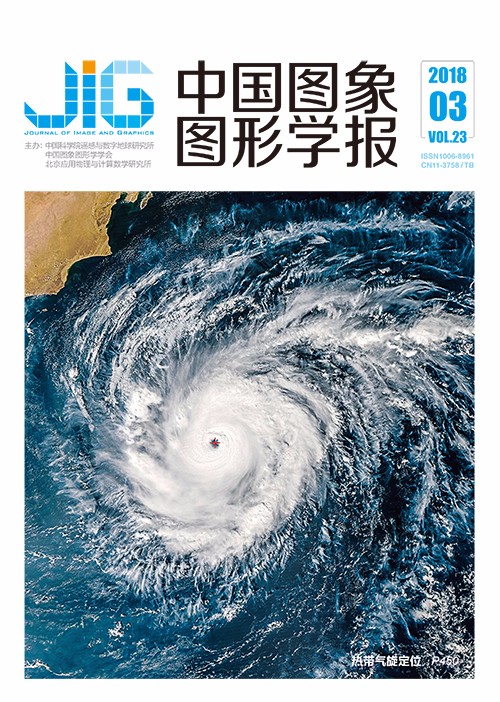
红外数字TDI成像非均匀性校正
杨洪飞1,2,3, 夏晖1,3, 马贝1,2,3, 孙胜利1,3, 饶鹏1,3(1.中国科学院上海技术物理研究所, 上海 200083;2.中国科学院大学, 北京 100049;3.中国科学院红外探测与成像技术重点实验室, 上海 200083) 摘 要
目的 红外数字TDI(time delay integration)先经过信号的模拟数字转换,再进行时间延迟累加,曝光方式比较灵活,能够提高探测系统灵敏度以及探测目标信噪比,在航空航天遥感应用领域具有广泛的应用,红外数字TDI通常采用扫描方式成像,既具有扫描成像的特点,其本身又是一个小面阵,在信息获取上具有扫描和凝视双重特性,在信息处理端,成像非均匀性是限制其成像质量的关键因素,降低输出图像的非均匀性,对开展目标探测、识别等研究和应用具有重要意义。方法 通过分析成像系统的每个部分,建立成像输入输出模型,并讨论模型中各个参数对成像非均匀性的影响,指出优化系统非均匀性的途径;对图像非均匀性校正分为盲元补偿和有效像元的非均匀性校正,对盲元进行邻域像素替代和邻域像素平均的交替迭代补偿提高了盲元的补偿率,对有效像元分析了所有像元的响应特性,选择了曲线拟合的目标校正曲线对系统灰度输出与输入能量之间的非线性进行校正,并引入校正因子对非扫描方向上的非均匀性进一步校正。结果 使用上海技术物理研究所研制的640×8中波红外数字TDI探测器进行了黑体定标验证,结果表明,在特定温度下的黑体成像经过校正后的非均匀性由19.44%下降到4.01%,外场实验获得的红外TDI图像上的横条纹明显减少和弱化。结论 通过分析对目标场景成像从光信号到电信号的整个链路,得到影响成像非均匀性的具体参数,对红外数字TDI成像系统设计具有一定参考意义;使用本文方法对红外数字TDI成像进行了盲元补偿和非均匀性校正,成像非均匀性显著下降,验证了该方法的有效性。
关键词
Non-uniformity correction of infrared digital TDI imaging
Yang Hongfei1,2,3, Xia Hui1,3, Ma Bei1,2,3, Sun Shengli1,3, Rao Peng1,3(1.Shanghai Institute of Technical Physics, Chinese Academy of Sciences, Shanghai 200083, China;2.University of Chinese Academy of Sciences, Beijing 100049, China;3.Key Laboratory of Infrared Detection and Imaging, Chinese Academy of Sciences, Shanghai 200083, China) Abstract
Objective Infrared digital TDI(time delay integration) first converts analog signals into digital ones and accumulates time delay integration signals unlike traditional infrared analog TDI. Its exposure method is highly flexible and could improve system detection sensitivity and the signal-to-noise ratio of the target. Thus, infrared digital TDI is widely used in aerospace remote sensing applications. An infrared digital TDI image system usually works through scanning, along with the characteristic of gaze because the system could be regarded as a small area array detector. For information processing, infrared digital TDI imaging non-uniformity is the key factor in limiting image quality. Reducing the non-uniformity of the output image is of great significance to the research and application of target detector and identification. Method This study establishes an imaging input and output model by analyzing every part of the imaging system and discusses the influence of the parameters on the non-uniformity of imaging. This study also identifies the way to optimize the non-uniformity of the system. The non-uniformity correction of images includes blind element compensation and non-uniformity correction of an effective pixel. The compensating rate of the blind pixel is improved by iterating the compensated blind pixel with field pixel substitution and field pixel average. The response characteristics of all pixels are analyzed, and the nonlinearity between the grayscale output and the input energy is corrected by the optimized target calibration curve. The non-uniformity in the non-scanning direction is further corrected by introducing the correction factor. Result Blackbody calibration was performed by using a domestic 640×8 medium-wave infrared TDI detector. The two-point method, multi-point method, and our method were used for image non-uniformity correction. The blackbody temperature of radiation calibration ranged from 30℃ to 56℃, and the pixel response tended to saturate higher than 56℃. The integration time of the detector is fixed at the typical time for imaging of 0.4 ms. The two-point method takes 30℃ and 56℃ pixel response data as original data to estimate the pixel response value between them and the multi-point method takes the data from 30℃ to 56℃ every 2℃ interval. An observation of the response curve of the sampled pixels shows good linearity of the pixel response curve from 30℃ to 50℃; the curve from 50℃ to 56℃ indicates nonlinearity. Correction result shows that non-uniformity of 7.45% and 7.31% at 35℃ and 45℃ is better than that of 8.26% at 53℃ with the two-point method because the two-point data that estimate pixel value needs the pixel signal to fit a straight line between points. Unlike the two-point method, the multi-point method could take the two nearest points to compute the pixel value and consider the linearity between the two nearest points only. The non-uniformity result at a different temperature is approximately 5% better than the result of the two-point method. On the basis of the multi-point data correction, the distributions of all the pixel response curves are considered, and a reasonable target curve is chosen as the correction curve. Therefore, nonlinear fitting is added between the multi-point data, and the non-uniformity value is reduced to approximately 4% at each temperature, which indicates that the method is effective. An imaging experiment was conducted in the real-world environment, and a few pictures were processed according to the radiation calibration data. The horizontal stripes on the obtained infrared TDI images are reduced and weakened after correction with the proposed methods. Conclusion An analysis of the whole link for the target scene from the optical signal to the electrical signal clearly identifies the specific parameters that affect image non-uniformity. This finding has reference significance for the design of infrared digital TDI imaging systems. Blind pixel compensation and non-uniformity correction of the infrared digital TDI imaging system were performed by using the proposed method. The non-uniformity of the image was greatly decreased, and the effectiveness of the method was verified.
Keywords
|



 中国图象图形学报 │ 京ICP备05080539号-4 │ 本系统由
中国图象图形学报 │ 京ICP备05080539号-4 │ 本系统由